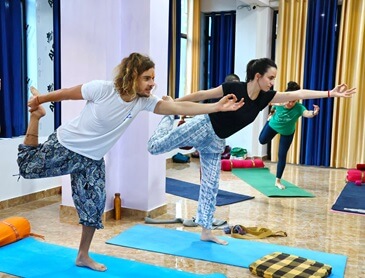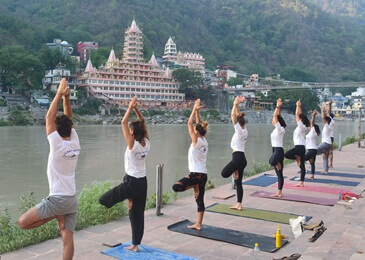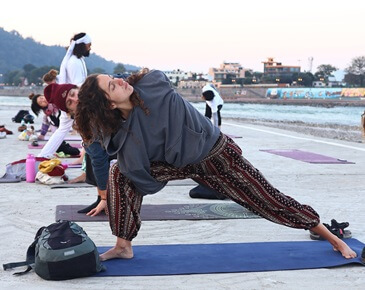
28 May 2024
Yoga, a practice that has been embraced for thousands of years, is not just about physical postures (asanas) but also about breath control (pranayama). The term 'pranayama' is derived from Sanskrit words 'prana' (life force or vital energy) and 'ayama' (extension or control). Pranayama, therefore, refers to the regulation of breath, a crucial aspect of yoga that influences both the mind and body. There are various types of breathing techniques in yoga, each serving different purposes and offering unique benefits. In this blog, we will explore some of the most common and beneficial types of yogic breathing.
1. Diaphragmatic Breathing (Adham Pranayama)
Diaphragmatic breathing, also known as abdominal or belly breathing, involves deep inhalations that fill the lungs and cause the abdomen to expand, followed by slow exhalations.
Benefits:
- Reduces stress and anxiety
- Lowers heart rate
- Improves lung function
- Enhances relaxation
How to Practice:
- Sit or lie down in a comfortable position.
- Place one hand on your chest and the other on your abdomen.
- Inhale deeply through your nose, allowing your abdomen to rise.
- Exhale slowly through your mouth or nose, feeling your abdomen fall.
- Repeat for several minutes, focusing on the rise and fall of your abdomen.
2. Ujjayi Breathing (Victorious Breath)
Ujjayi breathing, often referred to as ocean breath, involves a gentle constriction at the back of the throat, producing a soft, oceanic sound as you breathe in and out.
- Calms the mind
- Enhances focus and concentration
- Regulates body temperature
- Supports a meditative state
Benefits:
- Sit comfortably with a straight spine.
- Inhale deeply through your nose, slightly constricting the back of your throat.
- Exhale through your nose, maintaining the throat constriction to create the sound.
- Continue for several minutes, focusing on the sound of your breath.
How to Practice:
3. Nadi Shodhana (Alternate Nostril Breathing)
Nadi Shodhana, or alternate nostril breathing, involves inhaling and exhaling through alternate nostrils, believed to balance the hemispheres of the brain and cleanse the energy channels.
- Balances the nervous system
- Enhances mental clarity
- Reduces stress and anxiety
- Promotes overall well-being
Benefits:
How to Practice:
- Sit in a comfortable position with a straight spine.
- Use your right thumb to close your right nostril.
- Inhale slowly through your left nostril.
- Close your left nostril with your right ring finger, release your right nostril, and exhale through the right nostril.
- Inhale through the right nostril, then close the right nostril and exhale through the left.
- Continue alternating for several rounds.
4. Kapalabhati (Skull Shining Breath)
Kapalabhati is a vigorous breathing technique involving forceful exhalations followed by passive inhalations, aiming to energize and cleanse the respiratory system.
Benefits:
- Increases energy and alertness
- Detoxifies the lungs
- Strengthens the diaphragm
- Improves digestion
How to Practice:
- Sit comfortably with a straight spine.
- Take a deep breath in through your nose.
- Forcefully exhale through your nose by contracting your abdominal muscles.
- Allow the inhalation to happen passively.
- Repeat for 20-30 cycles, then take a deep breath and relax.
5. Bhramari (Bee Breath)
Bhramari, or bee breath, involves making a humming sound during exhalation, which has a calming effect on the mind.
Benefits:
- Reduces anxiety and stress
- Improves concentration
- Lowers blood pressure
- Calms the mind
How to Practice:
- Sit comfortably with a straight spine.
- Close your eyes and relax.
- Inhale deeply through your nose.
- Exhale slowly while making a humming sound, like a bee.
- Focus on the vibration in your head and chest.
- Repeat for 5-10 breaths.
6. Sheetali and Sheetkari (Cooling Breaths)
- Reduces anxiety and stress
- Improves concentration
- Lowers blood pressure
- Calms the mind
How to Practice:
- Sit comfortably with a straight spine.
- Close your eyes and relax.
- Inhale deeply through your nose.
- Exhale slowly while making a humming sound, like a bee.
- Focus on the vibration in your head and chest.
- Repeat for 5-10 breaths.
6. Sheetali and Sheetkari (Cooling Breaths)
Sheetali and Sheetkari are cooling breathing techniques that help lower body temperature and calm the mind.
Benefits:
- Cools the body
- Reduces stress
- Alleviates anger and anxiety
- Balances Pitta dosha (according to Ayurveda)
How to Practice Sheetali:
- Sit comfortably with a straight spine.
- Roll your tongue into a tube and stick it out slightly.
- Inhale through the tube of your tongue, feeling the cool air.
- Close your mouth and exhale through your nose.
- Repeat for several breaths.
How to Practice Sheetkari:
- Sit comfortably with a straight spine.
- Clench your teeth lightly and separate your lips.
- Inhale through the gaps between your teeth, feeling the cool air.
- Close your mouth and exhale through your nose.
- Repeat for several breaths.
7. Anulom Vilom (Alternate Nostril Breathing without Retention)
Similar to Nadi Shodhana, Anulom Vilom involves alternate nostril breathing but without holding the breath. It is aimed at balancing the body’s energy channels.
Benefits:
- Balances the nervous system
- Reduces stress
- Improves respiratory function
- Enhances mental clarity
How to Practice:
- Sit comfortably with a straight spine.
- Use your right thumb to close your right nostril.
- Inhale slowly through your left nostril.
- Close your left nostril with your right ring finger, release your right nostril, and exhale through the right nostril.
- Inhale through the right nostril, then close the right nostril and exhale through the left.
- Continue alternating without retaining the breath for several rounds.
Breathing is a fundamental aspect of yoga, deeply intertwined with the practice’s physical and mental benefits. Incorporating different types of pranayama into your daily routine can enhance your overall well-being, improve mental clarity, reduce stress, and foster a deeper connection with your inner self. Whether you are a beginner or an experienced practitioner, exploring these diverse breathing techniques can offer profound benefits and deepen your yoga practice. Remember to approach each technique with patience and mindfulness, allowing the breath to guide you towards greater harmony and peace.


